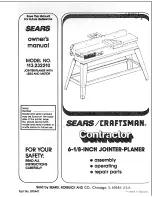
7
overreach your work surface, or use the planer
in an uncomfortable position. This will extend
the life of your tool, and decrease the risk of
accidents. Remember, safety and good results
depend on sharp, properly adjusted cutting
blades. Keep your planer blades clean and
sharp, and replace or reverse dull blades when
your planer no longer performs smooth, fast
cuts.
Planer Blades
CAUTION!
The planer blades are sharp and
fragile and must be handled carefully to avoid
injury to the user or damage to the blades .
The standard planer blades 24 have two cutting
edges, and may be reversed when one of the
cutting edges becomes dull or chipped. When
reversing or replacing blades, it is generally not
necessary to readjust the blade holders 26. If it
becomes necessary to adjust blade holder, take
planer to a Bosch Factory Service Center. To
avoid imbalance of the cutter drum 23, which
could result in vibration, premature tool wear
and poor work quality, always reverse or
replace blades as a set. Do not attempt to
sharpen used blades.
Reversing or Replacing Blades
To reverse or replace the blades loosen the
clamping screws 21 with blade wrench 9. With
the screws
l o o s e n e d ,
press the rab-
bet guard 25
down and slide
the blade
holder
26 and
blades
24
lengthwise out
of the cutter
drum 23, tak-
ing care to
keep your fin-
gers away
from the sharp
edges of the
blade. Next,
slide the blade
out of the blade
holder. A
piece of wood
may be used
10 23
26
24
22
20
21
25
9
Cord Length
Ampere Rating (shown on nameplate)
0-
2.1-
3.5-
5.1-
7.1-
12.1-
2.0
3.4
5.0
7.0
12.0
16.0
25'
18
18
18
18
16
14
50'
18
18
16
16
14
12
75'
18
18
16
14
12
10
100'
18
16
14
12
10
150'
16
14
12
12 Wire Gauge
Note: The smaller the gauge number, the larger
the wire is in the cord.
"SAVE THESE INSTRUCTIONS"
Operating the Tool
Trigger "ON/OFF" Switch
WARNING!
Hold the tool with both hands
while starting the tool, since torque from the
motor can cause the tool to twist.
To turn tool "ON", depress the "Lock-OFF"
button and squeeze the trigger switch 7. To turn
the tool "OFF", release the trigger switch which
is spring loaded and will return to "OFF" posi-
tion automatically.
To increase switch life, do not turn switch on
and off while tool is under the load.
Planing Action
Check that the workpiece is held in place se-
curely on your work surface, and standing
comfortably, hold the planer firmly with both
hands. With the planer fully adjusted, place the
front shoe 10 on the workpiece, (be certain that
the cutter drum 23 is not in contact with the
work) and start the planer as described earlier.
With pressure on the front shoe 10, and the
fence against the side of the work (to control the
width or angle,) feed the planer steadily until
the rear shoe 22 fully engages the workpiece.
Now gradually transfer pressure to the rear
shoe, and continue planing to the end of the cut.
Feed the planer at a uniform and reasonable
rate, which does not put excessive strain on the
motor or blades, (do not pull the planer back
over the surface already cut.) Use progressive
cuts until you are near the desired depth, and
then readjust to a light cut for the final pass to
obtain a good surface finish.
Use a smooth, even planing action, and do not
BM 2609931094 6/95
12/14/98, 4:20 PM
7
Содержание 3296
Страница 2: ...english 4 11 french 12 21 spanish 22 33 BM 2609931094 6 95 12 14 98 4 19 PM 2 ...
Страница 3: ...31 31 1 2 5 3 4 6 8 7 9 10 11 12 13 16 15 14 19 18 17 12 BM 2609931094 6 95 12 14 98 4 19 PM 3 ...
Страница 31: ...31 Notes BM 2609931094 6 95 12 14 98 4 20 PM 31 ...
Страница 32: ...Notes BM 2609931094 6 95 12 14 98 4 20 PM 32 ...
Страница 33: ...Notes BM 2609931094 6 95 12 14 98 4 20 PM 33 ...








































